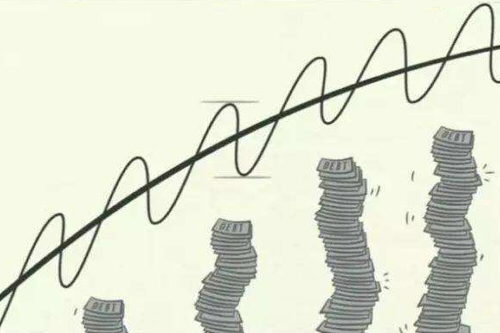Buttonwood: Credit Watch
梧桐:信贷观察
A new book argues that investors should focus on the credit cycle, not economic growth
一本新书指出:投资者应当关注信贷周期,而不是经济增长
When this millennium began, investors were confident that an era of high stock market returns was here to stay. Not only were American share prices at record-high valuations but books like “Dow 36,000” and “Dow 100,000” promised much more to come.
千禧年开始之际,投资者信心满满,认为股票市场高回报的时代已经来临并将永远存在下去。不仅美国的股票价格处于估值的历史高点,而且一些出版物,如《道指36000点》《道指100000点》等书籍也在向投资者鼓吹:没有最高只有更高。
Alas, the first decade of the 21st century proved a great disappointment. There were two big equity downturns, in 2000-02 and 2007-08; the average pension plan in the OECD achieved a miserly return of just 0.1% a year.
唉!可是事实证明,21世纪头十年是让投资者极度失望的十年。在此期间发生了两次重大股灾,一次是在2000年至2002年间,另一次是在2007年至2008年;在经合组织成员国中,养老金计划的年均收益率仅为可怜的0.1%。
In a new book Thomas Aubrey, a credit analyst, argues that investors have been led astray by the belief that economic growth drives asset-market returns. Not only is it difficult to forecast the economy, studies show there is little relationship between GDP growth and equity returns. First, many quoted companies are multinationals. Second, economic growth is often accompanied by new equity issuance, so the full benefits of growth do not accrue to existing shareholders. And third, it is quite possible for profits to rise much more rapidly when GDP is sluggish, as has indeed been the case in recent years.
信贷分析师托马斯·奥布里在其新书中指出,投资者一直都因“经济增长推高投资收益”这一信条而误入歧途。但相关研究显示,不仅经济难以预测,而且GDP增长与投资回报之间也几乎没有任何关系。其原因有三:第一,多数上市公司都是跨国公司;第二,经济增长常常伴随着新股的发行,因此增长的收益不可能全都落实到现有股东身上;第三,正如近几年的情况那样,当GDP萎靡不振时,利润的增长确确实实有可能比以前更快。
Instead, investors should focus on the credit cycle. The idea derives from Knut Wicksell, a Swedish economist, whose book “Interest and Prices” was published way back in 1898. The basic concept, later taken up by the Austrian economic school, is as follows. When things are in equilibrium, the return on capital (the profits of businesses) should equal the cost of capital (their borrowing costs). If the return on capital is higher than the cost, there will be great demand for credit and an economic boom will ensue. If the return on capital is lower than the cost, there will be a slump as companies go out of business.
相反,投资者应当关注信贷周期。奥布里的分析脱胎于瑞典经济学家克努特·维克塞尔早在1898年出版的《利息与价格》一书中所提出的思想。后来,该理论又被奥地利学派继承。其具体内容如下:在均衡的条件下,资本的回报(即商业利润)应当等同于资本的成本(即借贷成本)。如果回报高于成本,就会存在大量的信贷需求,随之而来的将是经济过热;如果回报低于成本,随着公司纷纷倒闭,经济会陷入衰退。
Mr Aubrey adds the observation that, although businesses know their funding costs, they cannot know their future return on capital. As a result, “entrepreneurs are continually surprised by the differences between actual returns compared with expected returns, which is the cause of the dynamic nature of the economy.”
奥布里对此又做了一些补充。他认为,尽管企业清楚它们的资金成本,但是它们不知道资本的未来回报是多少。结果,“实际回报与预期回报之间的差异常常让企业家感到惊讶,而这正是经济具有动态特征的原因。”

This analysis prompts him to suggest that investors should monitor the difference between the return and cost of capital, a figure he dubs “the Wicksellian differential”. Should the gap be positive and growing, equity prices will rise and the economy will take on more debt. If the gap is falling, equity prices will decline.
在这种分析的启发下,奥布里建议,投资者应当监控资本回报与资本成本之间的差额,他把这种差额称之为“维克塞尔差异”。如果两者之间的差额存在并且不断扩大,股票价格就会上涨,经济体会承担更多的债务;如果差额持续缩小,股票价格就会下跌。
The tricky bit lies in estimating these two numbers. Mr Aubrey uses the return on the corporate sector’s invested capital (both debt and equity) for the return on capital, and the five-year moving average of five-year government-bond yields for the cost of capital. This second measure is hardly ideal: even in times of fiscal crisis few companies can borrow as cheaply as the government. But it is the change in trend that matters, and the government-bond yield is at least a consistent measure.
这种分析方法难在如何估算这两个数字。为此,奥布里用企业已投入资本(既包括债务也包括股票)的回报来代替资本回报,用五年期国债收益率的5年移动平均值来代替资本成本。其中的第二个标准几乎完美无缺。因为,即使在财政危机期间,也很少有企业能以比政府还要低的成本筹措到资金。但是,5年移动平均值正是那种起作用的趋势变化,同时国债收益率至少也是一种与其相一致的衡量标准。
Mr Aubrey backtested his model between 1986 and 2011, switching into equities when the gap was widening and into government bonds when it was narrowing. The approach would have earned an 8.7% average real return from American assets between 1986 and 2011, more than either equities or bonds would have earned on their own.
奥布里把他的模型放到1986年至2011年之间进行了回归验证,当资本回报与资本成本之间的差额扩大时,就将资金投入到股票市场;当差额缩小时,就转战政府债券。按照这个模型所提供的方法,如果在1986年至2011年间投资于美国资本市场,扣除通胀因素后,其年均收益率为8.7%,比分别投资于股票和债券的收益都要高。
This outperformance occurred even though the model would have switched investors into government bonds from 1996 to 1999, missing the dotcom boom. The model performed far better in the recent crisis, switching investors into government bonds in 2007 and 2008 and back into equities in time for the strong stockmarket rally of 2009 and 2010.
即便投资者按照该模型在1996年至1999年间转投国债,从而错过科技类股票的大幅上涨,该模型依旧会有杰出的表现。在最近的这场危机,该模型表现得更为出色:如果投资者按照该模型在2007年和2008年转投国债,就会躲过当时的股灾;如果投资者随后又因2009年和2010年的大涨而及时撤回到股票市场的话,就能大赚一笔。
At this point, a note of caution is needed. Analyse the data for long enough and it will always be possible to find a model that, in the past, would have delivered outsize returns. All too often, however, such models fail to perform when investors try to use them in practice. For the current year Mr Aubrey says his model favours American equities; the British market is less promising.
关于这一点,投资者有必要保持一丝谨慎。只要接受分析的数据的时间跨度足够长,那么就总有可能找到一种能够在过去的时间里提供超额回报的模型。然而,事实一再告诉我们:当投资者试图将此类模型应用于实践时,模型总是失灵。至于今年,奥布里称他的模型看好美国股票。相比之下,英国市场则没有多少前途。
Even if that turns out to be wrong, at least he is looking in the right direction. His thesis echoes “Manias, Panics and Crashes”, the classic study of bubbles by Charles Kindleberger, which suggested that “the cycle of manias and panics results from the procyclical changes in the supply of credit” as optimistic businesses and consumers take on more debt during booms, only for banks to stop lending in the busts. Anyone who read Kindleberger’s book in 1978 was at least forewarned about the past two decades.
即便奥布里的模型最终被证实是错误的,那么这至少也说明他的方向还是正确的。他的理论契合了由查尔斯·金德伯格提出的“疯狂、恐慌和崩溃”的经典泡沫理论,该理论认为,由于乐观的企业和消费者在繁荣期间承担了更多的债务,仅仅是为了让银行在泡沫期间停止放贷,因此“疯狂和恐慌的周期是信贷供应顺周期变化的结果”。任何一位在1978年就拜读过金德伯格书籍的投资者至少能对已经过去的二十年做出提前预警。
英文、中文版本下载:http://www.yingyushijie.com/shop/source/detail/id/540.html








